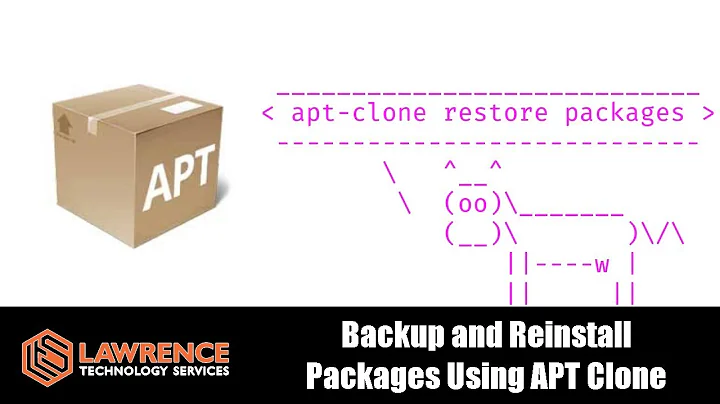How to reinstall a package using 'apt-get'?
Solution 1
$ man apt-get | grep reinsta -A2
--reinstall
Re-Install packages that are already installed and at the newest
version. Configuration Item: APT::Get::ReInstall.
So, to use it to reinstall aptitude use:
sudo apt-get install --reinstall aptitude
Solution 2
You can reinstall a package with sudo apt-get install --reinstall packagename.
This completely removes the package (but not the packages that depend on it), then reinstalls the package.
This can be convenient when the package has many reverse dependencies.
Solution 3
Sometimes you need to restore config files too! not just reinstall.
sudo apt-get install --reinstall xxxx
Reinstall the application, keeps the config files.
This could be helpful, but sometimes you need to start fresh, so what I use is this:
sudo dpkg -r xxxx //to remove that xxxx package
sudo dpkg -P xxxx //to purge all related files
then
sudo apt-get install xxxx
Solution 4
You should be safe to remove aptitude and reinstall, as that won't affect the other apt utilities. So: apt-get remove aptitude followed by apt-get install aptitude, or if that still fails try apt-get purge aptitude followed by apt-get install aptitude.
Before doing either of the above, I recommend a full file-system and bad-block check in case there is a problem there that caused the problem (depending on the problem, if there is one, further activity could make things worse). Also, make sure you review what will be removed in the remove/purge step before letting it proceed (it should pause to ask for permission if anything extra is changed as a result of removing that one package), to double check my thought that this is safe.
Solution 5
If you want a reinstall with complete config wipe: sudo apt remove --purge package sudo apt install package
That's like you never had installed the package before. I am doing this often with motion and such things.
Related videos on Youtube
Shashi
Updated on September 17, 2022Comments
-
 Shashi almost 2 years
Shashi almost 2 yearsI am developing a class in X++. In this class I need to send messages to third party application using a WCF custom channel written C#.
So my questions are: 1) Is it possible to create and use a WCF custom channel to send message inside a X++ method?
2) In WCF, channels are created using channel factories. They are declared something like
IChannelFactory<IOutputChannel> fact;Can this be done in X++ also?Thanks in advance
-
 Admin about 2 yearsThese are great two separate questions. One is how to reinstall a package, which is in the title and which is answered. The other one is, how to deal with aptitude crash on a too wide terminal.
Admin about 2 yearsThese are great two separate questions. One is how to reinstall a package, which is in the title and which is answered. The other one is, how to deal with aptitude crash on a too wide terminal.
-
-
Yejin over 14 yearsThanks a lot!
apt-get removefollowed byapt-get installdid the trick! -
Yejin over 14 yearsIt's a long time ago that I did things like
a full filesystem checkor similar. Could you please give me a short hint howto do that? -
 David Spillett over 14 years
David Spillett over 14 yearsfsck -f <block_device>such asfsck /dev/sda1. The filesystem will need to be unmounted or mounted read-only at the time so as this is likely to be your root filesystem you should reboot into single-user-mode or boot from something else like a live cd. -
Yejin over 14 yearswhat's that
-A5you are grepping ? -
Yejin over 14 years@David: Is there a way to force a
filesystem check on next reboot? -
user1686 over 14 yearsman grep | grep -- "-A"
-
 David Spillett over 14 yearsYou can use
David Spillett over 14 yearsYou can usetune2fsto mark the filesystem as having been mounted more times than its set limit, that should force a check next boot. Assuming the filesystem is ext2/3/4:tune2fs -C 99 <device>, or in case you have mount count based checking turned off, turn it on at the same time with something liketune2fs -c 17 -C 99 <device>. -
user23307 over 14 yearstouch /forcefsck;reboot
-
Cerin about 11 yearsThank you for being the only correct, complete, non-snarky answer.
-
Cerin about 11 years@DavidSpillett, I strongly disagree. The man pages are usually very poorly written and are very unfriendly to newbies. For example, the paragraph on the "--reinstall" option doesn't mention that you have to use it with the "install" argument. A newbie might rightfully ask "why do I have to tell it to install AND reinstall?" An answer telling someone to RTFM is the worst kind of answer and it pains me to see it with the most votes, especially when a complete and actually helpful answer is near the bottom.
-
Desty almost 10 yearsWhat's that
--you're grepping? -
Tino over 9 years
man getopt, look underPARSING -
 jjmontes over 9 years
jjmontes over 9 years-A5shows the matched line plus the following 5 lines.--stops parsing of options, thus interpreting anything that comes after as positional arguments, avoiding having to escape the dash in the expression-Awhich would otherwise be interpreted as an option to grep itself. -
 Dimitry K over 9 years@jjmontes So technically quotes around
Dimitry K over 9 years@jjmontes So technically quotes around"-A"are not necesary:man grep | grep -- -A -
Skippy le Grand Gourou over 9 yearsAnd if you need to restore config files only, in some cases (if they are managed by ucf) you should use
UCF_FORCE_CONFFMISS=1 apt-get --reinstall install [pkgname]. -
 Kar.ma over 5 yearsThis answer deserves a BIG upvote.This is what you need when you want to "fully reinstall" a package. E.g. a simple --reinstall of vsftpd doesn't re-create the config file, even if the file doesn't exist anymore. A "Remove+Purge+(Re)install" does the job instead.
Kar.ma over 5 yearsThis answer deserves a BIG upvote.This is what you need when you want to "fully reinstall" a package. E.g. a simple --reinstall of vsftpd doesn't re-create the config file, even if the file doesn't exist anymore. A "Remove+Purge+(Re)install" does the job instead. -
 Alexis Wilke over 3 yearsThe problem with that technique is that it deletes all your changes to the settings under
Alexis Wilke over 3 yearsThe problem with that technique is that it deletes all your changes to the settings under/etc/...which may not be what you want... -
 Niwla23 over 3 yearsIn other cases it can be exactly what you want. Sometimes you just want to get back original config or just do a cleanup
Niwla23 over 3 yearsIn other cases it can be exactly what you want. Sometimes you just want to get back original config or just do a cleanup -
 Alexis Wilke over 3 yearsAbsolutely. Actually, when I test my new packages I do that a lot until I'm satisfied with the installation process. So it can be very useful. On the other hand, it can be a gotcha if you don't first backup your settings with some specific data which you don't have anywhere else (you probably can come up with it again, but it can be time consuming).
Alexis Wilke over 3 yearsAbsolutely. Actually, when I test my new packages I do that a lot until I'm satisfied with the installation process. So it can be very useful. On the other hand, it can be a gotcha if you don't first backup your settings with some specific data which you don't have anywhere else (you probably can come up with it again, but it can be time consuming). -
Mikko Rantalainen almost 3 years@DimitryK Yes,
grep -- "-A"is exactly the same thing asgrep -- -A. The quotes are interpreted by the shell andgrepalways sees the second parameter as-A. And obviously the--is required before that to make sure it's interpreted as query instead of flag-A. (Windows programmers will have different experience becausecmdhas much less smarts than UNIX shell.) -
Flimm almost 3 yearsYou can use
aptinsteadapt-gettoo:sudo apt install --reinstall packagename


![EXPLAINED: How to Install/Uninstall Program in Linux Using PACKAGE MANAGERS [apt, dpkg, yum, rpm]](https://i.ytimg.com/vi/RC7bvzIqxS8/hq720.jpg?sqp=-oaymwEcCNAFEJQDSFXyq4qpAw4IARUAAIhCGAFwAcABBg==&rs=AOn4CLDJP6ot7df-YE8GltC1xkblE3uZnw)

